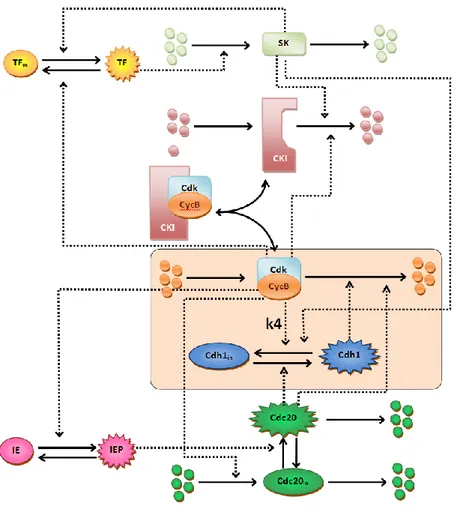Technical Report CoSBi 23/2008
An analysis of irreversible transitions in a
model of the buddying yeast cell cycle
Paolo Ballarini CoSBi, Trento, Italy [email protected]
Tommaso Mazza CoSBi, Trento, Italy
[email protected] Alida Palmisano CoSBi, Trento, Italy
Dipartimento di Ingegneria e Scienza dell’Informazione, Universit`a di Trento, Italy
[email protected] Attila Csikasz-Nagy CoSBi, Trento, Italy [email protected]
This is the preliminary version of a paper that will appear in
Proceedings of the third International Workshop on Practical Applications of Stochastic Modelling (PASM 2008), ENTCS 232, pp. 39-53, 2009
An analysis of irreversible transitions in a model of
the buddying yeast cell cycle
Paolo Ballarini, Tommaso Mazza, Alida Palmisano, Attila Csikasz-Nagy
Abstract
Cells life follows a cycling behaviour which starts at cell birth and leads to cell division through a number of distinct phases. The tran-sitions through the various cell cycle phases are controlled by a com-plex network of signalling pathways. Many cell cycle transitions are irreversible: once they are started they must reach completion. In this study we investigate the existence of conditions which lead to cases when irreversibility may be broken. Specifically, we characterise the elements of the cell cycle signalling network that are responsible for the irreversibility and we determine conditions for which the irre-versible transitions may become reirre-versible. We illustrate our results through a formal approach in which stochastic simulation analysis and model checking verification are combined. Through probabilistic model checking we provide a quantitative measure for the probability of irre-versibility in the “Start” transition of the cell cycle.
The cell division cycle is a coordinated set of processes by which a cell replicates all its components and divides into two nearly identical daughter cells. The eukaryotic cell cycle is driven by an underlying molecular net-work which centers around complexes of cyclin dependent kinases (Cdk’s) and their regulatory cyclin partners. Active Cdk/cyclin (CycB) complexes can induce critical cell cycle processes by phosphorylating target molecules [3]. The activity of this complex can be regulated in several ways, one of which is the controlled degradation of the cyclin subunit. The Anaphase Promoting Complex (APC) with help from the regulatory protein Cdh1 labels cyclins for degradation at the end of the cell cycle. Interestingly, Cdk/CycB complex can phosphorylate and inactivate Cdh1 proteins, which leads to an antagonistic relation between Cdk/CycB and Cdh1/APC [7].
Figure 1: Simple budding yeast cell cycle model. Solid arrows repre-sent transitions, dashed arrows stand for regulatory interactions. The core Cdk/CycB - Cdh1/APC module is highlighted. We also point to the reac-tion rate which we change during the analysis and that is responsible for the irreversibility of the cycle.
since cyclin degradation is slowed down after Cdh1 got inactivated. This increased Cdk/CycB activity can induce DNA replication, thus the cells enter into S-phase. This event, when Cdk/CycB activity abruptly increases and the cells enter into S-phase is called “Start” transition of the cell cycle [4].
Mathematical models have been investigating the dynamics of the interac-tions that drive this transition [1, 5]. It has been proposed that the positive feedback loop that is the result of this antagonism between Cdk/CycB and Cdh1/APC (also called double negative feedback, since the two negative ef-fects bring together a positive loop) can create bistability and hysteresis in the system [1]. Furthermore it has been proposed that this simple module can be responsible for the irreversibility of the Start transition of the cell cycle [6]. Experiments proved the existence of bistability in the cell cycle of budding yeast cells [2], but the irreversibility of this transition was never tested yet.
In this work we will present an analysis of this module by application of both probabilistic model checking and stochastic simulations on a simple budding yeast cell cycle model. More specifically we show that irreversibility can be removed from the system by weakening the positive feedback loop.
Our results provide a quantitative measure for the irreversibility of the Start transition of the cell cycle, reached by probabilistic model checking of the Cdk/CycB - Cdh1/APC core module of cell cycle regulation. We show that by weakening the strength of the positive feedback loop (by reducing k4) the irreversibility is getting lost. With stochastic simulations of a budding yeast cell cycle model (that includes the auxiliary regulators of this module) we show that indeed the above mentioned parameter variations can perturb the irreversibility of the Start transition of the cell cycle. Future directions include extensions of such methodology (i.e. quantitative analysis of cell cycle irreversibility based on probabilistic model checking verification) to analyze the role that other reactions/rates have in the irreversibility of the cell cycle. A CTMC model of the cell cycle wild-type network of signal (Figure 1) is currently being studied.
References
[1] K.C. Chen, A. Csikasz-Nagy, B. Gyorffy, J. Val, B. Novak, and J.J Tyson. Kinetic analysis of a molecular model of the budding yeast cell cycle. Mol Biol Cell, 11(369-391), 2000.
[2] F.R. Cross, V. Archambault, M. Miller, and M. Klovstad. Testing a mathematical model for the yeast cell cycle. Mol Biol Cell, 13:52–70, 2002.
[3] D.O. Morgan. Principles of cdk regulation. Nature, (374):131–134, 1995. [4] D.O. Morgan. The cell cycle: Principles of control. New Science Press,
2006.
[5] B. Novak, A. Csikasz-Nagy B. Gyorffy, K. Nasmyth, and J.J. Tyson. Model scenarios for evolution of the eukaryotic cell cycle. Phil Trans R Soc Lond B, Vol. 353:2063–2076, 1998.
[6] B. Novak, J.J. Tyson, B. Gyorffy, and A. Csikasz-Nagy. Irreversible cell-cycle transitions are due to systems-level feedback. Nat Cell Biol, 9(7):724–728, 2007.
[7] W. Zachariae and K. Nasmyth. Whose end is destruction: cell division and the anaphase-promoting complex. Genes Dev, 13:2039–2058, 1999.
